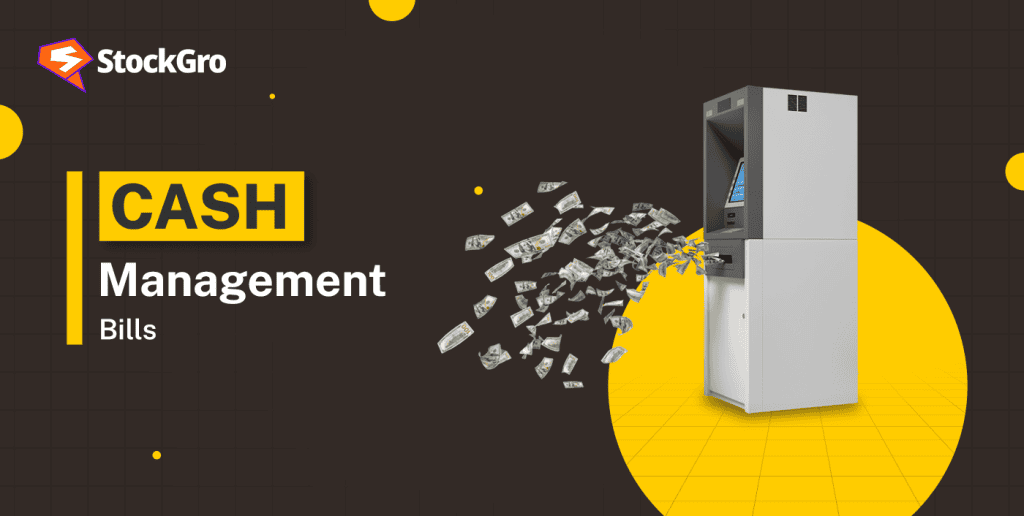
Governments throughout the world use various sources of finance to fund their short and long term needs. The Government of India also uses these debt instruments to fulfill its financial needs. These instruments have long and short term maturities.
One such instrument which is widely used by the government to fulfill its short term financing needs are cash management bills. Let us understand more about these bills.
Cash management bills
Government of India in consultation with the Reserve bank issues Cash management bills to fund its short term cash flow mismatch and emergency requirements. Treasury bills, Ways and Means Advances (WMA) and cash management bills have been an important tool in the government’s fund raising toolkit.
The government needs CMBs for various purposes, for example often there are mismatches between GST collection and scheduled expenditure, debt servicing needs, economic shocks etc.
These bills were introduced in August 2009 and first issuance was done on 12th May 2011. These bills are issued as and when required by the government. For example in the first quarter of financial year 2025, the government did not use this facility to raise funds. (Source: Public debt management report)
Also read: Government bonds in India – Meaning, types and features
Features of cash management bills
Some key features of cash management bills in finance are as follows: (Source: DEA)
Shorter maturities: CMBs have tenures of less than 91 days. The government determines the duration based on its needs, which can range from just a few days to a maximum of 91 days.
Irregular issuance: Unlike certain T-bills that have a defined date for issuance, cash management bills are issued as needed. They only come into play when a government needs short-term funding.
Zero Coupon issuance: These bills do not bear an interest or coupon payment these bills are issued at a discount and redeemed at par. The CMBs are issued in ₹10,000 denomination and settled on a T+1 basis.
SLR requirement: Under Section 24 of the Banking Regulation Act of 1949, Banks can hold CMBs to fulfill their Statutory liquidity ratio (SLR) requirements which makes CMBs highly liquid.
High safety: These bills are backed by the government of India which is why the investors deem them safe to invest and carry minimal default risk, unlike other debt instruments that are deemed risky.
Also read: Corporate bond – definition and how they’re bought and sold
Auction mechanism for issuance
RBI controls the process of issuing CMBs from announcement to final settlement. RBI announces the details of issuance, like tenure, auction date, etc, one day before, and Banks, mutual funds, and other institutions submit their bids.
The bids submitted are for the lowest yield the investors are willing to accept. The lowest bids win and are allotted the bills. Winning bids are allotted CMBs, and the securities are settled on a T+1 basis. All bids must be competitive; non-competitive bids are not permitted for CMBs.
The issuance process for cash management bills is swift, providing the government with timely liquidity.
Difference between T-Bills, CMBs and WMAs
In addition to CMBs, the government issues treasury bills (T-Bills) and Ways and Means Advances (WMAs). Here’s how these short-term debt instruments compare:
| Critera | CMBs | T-Bills | WMAs |
| Maturity Period | Less than 91 days | 91, 182 or 364 days(Source: RBI) | Maximum of 90 days (Source: RBI) |
| Interest payment | Zero Coupon (Sold at discount, redeemed at par) | Zero Coupon (Sold at discount, redeemed at par) | Charge an interest rate (repo rate) |
| Issuance style | As per the requirement | Regularly scheduled | As per the requirement |
| Rate of return | Decided by auctions | Decided by auctions | Linked to RBI repo rate |
| Investors | Banks, mutual funds, institutions, individuals etc. | Banks, mutual funds, institutions, individuals etc. | Not available for investors, only for governments |
| Purpose | Cash flow mismatch | General short term borrowing needs | Temporary overdraft facility |
Key differences include:
- CMBs and WMAs are issued for shorter periods of not more than 91 days, whereas WMAs are issued for slightly longer periods of up to 364 days.
- WMAs are interest-bearing instruments, whereas CMBs and T-Bills are issued at a discount and redeemed at par.
- T-Bills usually have a weekly issuance schedule but WMAs and CMBs are issued only as per requirements.
- In contrast to CMBs and T-Bills, which are issued to investors, WMAs are issued by the RBI to governments to raise money.
Also read: Bank rate vs. Repo rate – Understanding the key differences
Bottomline
Cash management bills in India serve as an effective tool for the government to raise funds to address short-term cash flow mismatches. They offer a safe avenue for investors to park short-term cash. CMBs were essential during the COVID-19 pandemic. It will play an important role in future unpredictable economic shocks. Any policymakers, investors, etc, trying to understand the dynamics of public financing have to understand the dynamics of CMBs.
FAQs
1: What are Cash management bills?
Cash Management Bills are short-term securities issued by the government, in consultation with the Reserve Bank of India (RBI), to address immediate cash flow needs. These bills typically have maturity periods ranging from a few days to less than 91 days and are settled on a T+1 basis
2: Why are cash management bills used?
When a government has short-term cash needs due to an economic shock, delay in tax revenue, urgent long-term debt servicing requirement, etc it issues CMBs to fulfill that need. With CMBs, Any short-term cash flow imbalance that arises now can be resolved.
3: Why do investors invest in CMBs?
CMBs are considered low-risk investments as they are backed by the government, which significantly reduces the chance of default. Additionally, their short-term nature provides high liquidity, making them an attractive option for investors seeking a secure place to park funds temporarily.
4: What is the difference between CMBs and T-Bills?
T-Bills have maturities of up to 364 days, while CMBs are limited to a maximum of 91 days. T-Bills are issued on a regular basis to meet general cash flow requirements, whereas CMBs are issued specifically to address short-term cash mismatches.
5: Are CMBs safe for investment?
Yes, CMBs are regarded as a very safe investment. The backing by the sovereign increases their reliability and reduces default risk. Their short-term nature also helps mitigate exposure to long-term financial uncertainties, making them a prudent choice for investors.

